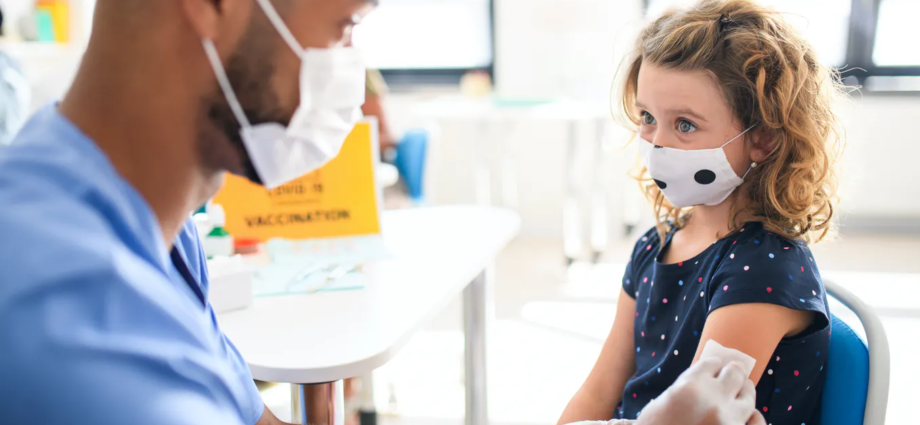Should children get the COVID-19 vaccine?
Establishing public trust is now central to any decisions regarding the inoculation of our child population. (Shutterstock)
Michael Hefferon, Queen’s University, Ontario
January 19, 2021
As COVID-19 vaccination for adults rolls out, it’s time to consider the wisdom (or otherwise) of vaccinating our children. Indications to vaccinate a child population could include:
- A pandemic causing severe and widespread illness/mortality in the child population.
- A residual pool of young hosts that are spreading a lethal disease to the general population.
- An infectious disease in young population that’s led to suspension of educational, social and athletic activities crucial to normal development.
- A selected subgroup of children who are at risk from this virus because of pre-existing conditions that make them vulnerable to COVID-19.
Remember, these Pfizer, Moderna and other vaccines have been approved for emergency use for a condition that is causing significant morbidity and mortality in the adult population, and is overburdening the health-care system — in addition to overwhelming our everyday lives.
In pediatrics, we are often asked what’s the definition of a child. Well, since Pfizer trials have included people 16 years and older, then for these purposes we are really looking at birth to 15 years.
Should we really be vaccinating our children if the disease has very little adverse consequences for their age group? Historically, we have immunized against diseases like polio and diphtheria that were a clear danger to children.
The same cannot be said for SARS-CoV-2 — symptoms are mostly mild, which is leading to a suspicion that we have failed to identify many active cases. Some very low mortality has unfortunately still occurred, but almost exclusively in children with serious pre-existing conditions — such as heart, lung or immunodeficiency syndromes — and in infants under one year of age.
It’s important to add that children have been harbouring non-COVID-19 coronaviruses for years, with little more than a sniffle.
A rare complication of COVID-19 in children is MIC-S — a multisystem inflammatory syndrome, which is serious, but also treatable.

Herd immunity
Realistically, the nature of the pandemic means no one may be safe until everyone is safe. Herd immunity may not be possible when there are seven million children in Canada (20 per cent of the population) unimmunized.
Can we really classify vaccinating children against COVID-19 as emergency use?
First, let’s consider that a child giving immunization consent is not the same as an adult agreeing to have a shot. Parents will have to give proxy consent in most cases. To get to that point will require feedback from trials done in the zero-to-16 age group.
Parents approached about their willingness to enrol their children in such trials have agreed in only 14-18 per cent of cases. Those assenting to their child taking part in a trial were more likely to enrol in one themselves, and more likely to have their own kids fully vaccinated against other diseases.
Moderna has struggled to find 3,000 adolescents to take part in a trial for those aged 12-18, announced on Dec. 10, 2020. (The size of adult trials has been around 40,000 participants.) It would seem wise to complete a trial on this adolescent age group before embarking on an early childhood trial.
Trials involving children 11 years and younger will take longer, partly because the doses of vaccine will need to be de-escalated to lower strengths relative to the child’s weight. Approval may need to have a higher threshold, and emergency roll out may not be deemed applicable. Thus we should not expect an authorization for such a product before 2022.
Public trust
Currently the American Association of Pediatrics puts COVID-19 deaths among children at 0.06 per cent of total deaths. But numbers don’t tell the full tragedy of this virus in pediatrics.
These small numbers are tragic consequences of a disease that seems to be preventable. But surely there is also a subgroup of identifiable patients (those with pre-existing conditions) who can be given the vaccine on an emergency authorization basis, once we have more data on vaccine safety in their age group — or even before. The vast majority of their caregivers will agree to the use of a vaccine in their special needs child once reassured by the medical profession.
Establishing public trust is now central to any decisions regarding the inoculation of our child population. We would need a safe vaccine with an overall acceptable level of risk for parents to agree to move forward with this decision. Currently there are significant numbers of adults who are vaccine hesitant regarding their own shot. Those hesitating on behalf of their children will be a challenge.
In addition to acting as a platform for safe reopening of schools, a school programme would be most practical to effect widespread administration of a childhood COVID-19 vaccine, as is the case of meningococcal and HPV vaccines.
Subscribe to our newsletter.
But questions remain. Are we mitigating harm or reducing transmission? Is the vaccine going to be as effective in the early years as it is for older folk? Would the rollout be mandatory? Like a lot of COVID-19 discussions, for now there are more questions than answers.
Michael Hefferon, Assistant Professor, Department of Pediatrics, Queen’s University, Ontario
This article is republished from The Conversation under a Creative Commons license. Read the original article.

